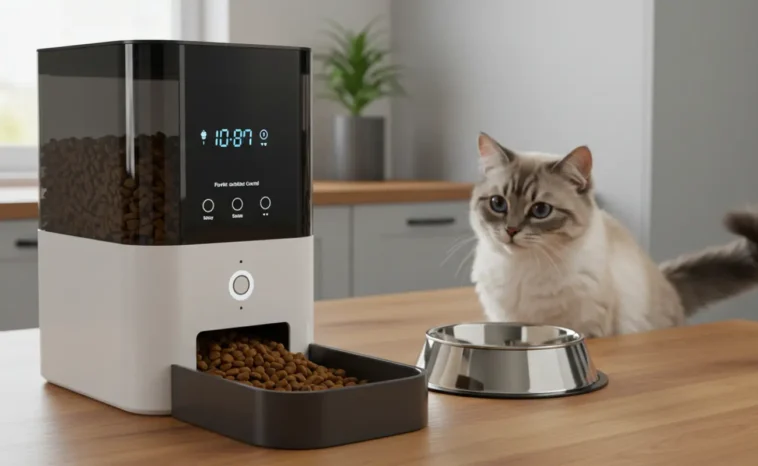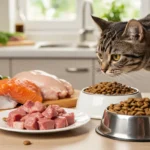Ever feel like you’re constantly on the lookout for feeding times or rummaging through cupboards to keep your cat satisfied? The solution might be simpler than you think: a food feeder for cats. In fact, using a food feeder for cats is becoming a staple in modern cat care, as it allows pet owners to manage mealtimes efficiently and keep their furry friends happy. If you’ve ever considered investing in a food feeder for cats, this article will walk you through everything you need to know—from the basic overview, to specific types like a food dispenser for cats, or even a food dispenser for cats with timer settings.
In the next sections, we’ll explore how these devices work, their benefits, how to choose one that’s right for your feline companion, and the potential challenges you might face. You’ll also learn practical tips, backed by expert opinions, to ensure a well-rounded perspective on using an automatic or manual feeder at home. By the end, you’ll have a clear understanding of how a feeder can transform your cat’s mealtime routine—and maybe even improve your own schedule!
food feeder for cats
Overview
A food feeder for cats is a device designed to dispense controlled portions of cat food at predetermined intervals or upon the pet owner’s command. These feeders come in a variety of forms, from simple gravity-based dispensers to digital devices with timers and smartphone connectivity. The main idea is to automate or streamline the feeding process so that:
- Your cat eats on schedule: Avoiding overfeeding or underfeeding.
- You have peace of mind: Even if you’re away or busy with work, you can ensure your cat doesn’t skip meals.
- You reduce food waste: By dispensing only what’s needed, feeders help prevent spillage or leftover kibble going stale.
This convenience has led to a surge in popularity for devices like a food dispenser for cats and, more specifically, food dispenser for cats with timer control features.
Key Features of Modern Cat Feeders
- Portion Control: Many feeders let you program exact serving sizes, helping with weight management.
- Automated Scheduling: Electronic feeders allow multiple feedings per day.
- Connectivity: Some advanced models can connect to your smartphone, allowing remote feeding.
- Durable Materials: Most feeders are made from BPA-free plastic or stainless steel to ensure food safety.
Whether you have a busy schedule, multiple pets, or a cat with specific dietary needs, feeders can be a game-changer. Let’s delve deeper into how these devices work and the different options available.
Different Types of Cat Feeders (Specific Aspect of the Topic)
Choosing the right food feeder for cats can be overwhelming, given the myriad of options on the market. Below, we break down the most common types and their features, to help you decide which might work best for you and your cat.
1. Gravity Feeders
How They Work
- A simple design using gravity to dispense kibble from a storage container into a bowl.
- As your cat eats from the bowl, more food trickles down to replace what’s gone.
Pros
- Budget-friendly and widely available.
- No need for electricity or batteries.
- Great for cats who self-regulate and don’t overeat.
Cons
- Doesn’t control portions; cats that tend to binge-eat might overindulge.
- Can be prone to food wastage if you’re not monitoring intake.
2. Programmable Electronic Feeders
How They Work
- An electronic mechanism dispenses a set amount of food at specific times of the day.
- You can program multiple meals, portion sizes, and feeding intervals.
Pros
- Ideal for cats that need strict portion control or timed feedings.
- Great for busy owners or those frequently away from home.
- Some models allow smartphone integration, letting you control the feeder remotely.
Cons
- Requires power or batteries, so you need to keep them charged or replaced.
- Can be more expensive than basic feeders.
3. Rotating/Carousel Feeders
How They Work
- Consist of several covered compartments that rotate based on a timer.
- At mealtime, the feeder uncovers one compartment, providing your cat with fresh food.
Pros
- Allows for pre-measured meals, preventing overeating.
- Keeps wet food fresh longer compared to some other feeders.
- Offers multiple slots, suitable for different meal times throughout the day.
Cons
- May be bulky and require more countertop or floor space.
- Cleaning can be a bit tedious due to multiple compartments.
4. Smart Feeders (Wi-Fi Enabled)
How They Work
- Similar to programmable feeders but come with an app that connects via Wi-Fi.
- You can customize feeding schedules, receive notifications, and even feed your cat on demand through your phone.
Pros
- Perfect for tech-savvy owners who want full control remotely.
- Allows for detailed feeding analytics (some apps track how much your cat eats).
Cons
- Often the most expensive option.
- Relies on a stable internet connection; if the Wi-Fi goes down, it might disrupt feeding.
Common Questions About food feeder for cats
Despite their growing popularity, people often have a host of questions regarding feeders. Here are some commonly asked ones:
1. Are Cat Feeders Suitable for Wet Food?
Most food dispensers for cats are designed for dry kibble. However, certain rotating or carousel-style feeders have airtight compartments that can handle wet food. You’ll need to ensure timely cleaning and possibly include ice packs if the feeder doesn’t come with a cooling element.
2. Do I Need a Timer on My Cat Feeder?
A food dispenser for cats with timer is extremely useful for portion control and scheduling. If your cat free-feeds responsibly, a simple gravity feeder might suffice. However, if you’re dealing with obesity issues or a cat on a strict diet, a timer can be a huge advantage.
3. Will My Cat Overeat with an Automatic Feeder?
Electronic feeders offer strict portion sizes, effectively preventing overeating. Gravity feeders, on the other hand, can encourage free-feeding. If you’re worried about your cat’s weight, a feeder with timer or portion control is the better choice.
4. Are Feeders Easy to Clean?
Most feeders come with removable trays or bowls for easy washing. Look for dishwasher-safe components to make cleaning simpler. Always follow the manufacturer’s guidelines to maintain hygiene and product durability.
5. Do Cat Feeders Work for Households with Multiple Cats?
They can, but you may need to consider your cats’ dynamics. One cat might eat more than its share if they share a single feeder. In multi-cat homes, you might need a separate food feeder for cats for each pet or a feeder that can detect specific microchips or collars.
Tips for Choosing and Using a Cat Feeder (Topic-Related Actions or Advice)
Bringing a food feeder for cats into your home is a commitment. Here are some tips to ensure you make the right choice and use it effectively:
-
Assess Your Cat’s Eating Habits
- If your cat grazes throughout the day, a gravity feeder might work.
- For a cat on a strict diet, opt for a programmable or smart feeder.
-
Consider Your Schedule
- If you travel often or work long hours, an automated timer-based dispenser is ideal.
- If you’re usually at home, a simpler feeder might suffice.
-
Evaluate Your Budget
- Basic gravity feeders cost very little.
- Smart feeders with mobile apps can be more expensive but offer added convenience and features.
-
Check for Pet Safety Features
- Look for BPA-free plastic or stainless steel.
- Ensure no sharp edges or pinch points that could harm your pet.
-
Introduce the Feeder Gradually
- Cats can be wary of new devices. Place the feeder in a familiar feeding area.
- Let your cat investigate it before relying on it for regular meals.
-
Regular Maintenance
- Clean bowls or trays at least once a day if possible.
- For wet food, be extra vigilant about cleaning to avoid bacterial growth.
-
Monitor Feeding
- Even if you have a feeder with a timer, check occasionally to ensure it’s functioning properly.
- Keep track of your cat’s weight and overall health, adjusting portions as needed.
Challenges and Solutions Related to food feeder for cats
Using a food feeder for cats can simplify your life, but it isn’t without its hurdles. Below are some common challenges and how to overcome them:
1. Technological Failures
- Challenge: Power outages, battery depletion, or Wi-Fi disruptions can halt automated feeding.
- Solution: Check batteries or power cords regularly. Keep a backup feeding method (like a small bowl of dry food) in case of emergencies.
2. Cat Tampering
- Challenge: Some clever cats learn to tip or nudge the feeder to get more food.
- Solution: Choose a stable, heavier feeder or one with a locking mechanism. If you notice your cat tampering with it, position it in a corner or secure it against a wall.
3. Multiple Pets
- Challenge: In a multi-pet household, dogs might access the cat feeder or dominant cats may hog the food.
- Solution: Use a microchip-enabled or collar-activated feeder for each cat. Place feeders in areas accessible only to the correct pet.
4. Transition Period
- Challenge: Cats may resist sudden changes to their feeding routines.
- Solution: Gradually introduce the feeder, initially placing regular meals in the new device. Offer positive reinforcement or treats around it.
5. Maintenance and Hygiene
- Challenge: Some feeders are cumbersome to disassemble and clean.
- Solution: Check for models with dishwasher-safe parts. Schedule weekly deep cleaning to keep bacterial growth at bay.
Benefits of Using a food feeder for cats
Integrating a food feeder for cats into your home can yield numerous advantages:
1. Convenience for Pet Owners
- Automated Schedules: No more rushing home to feed your cat.
- Less Worry: Travel or long workdays become less stressful when you know meals are taken care of.
2. Consistent Portion Control
- Weight Management: Proper portion sizes help prevent obesity and related health issues.
- Health Monitoring: Tracking how much your cat eats can alert you to health changes early.
3. Reduced Food Waste
- Precision: Feeders dispense the exact amount needed, minimizing leftovers.
- Cleaner Feeding Area: Less spilled food and fewer ants or pests attracted to the feeding spot.
4. Behavioral Benefits
- Meal Routine: Regular feeding times can improve your cat’s mood and behavior.
- Less Begging: If the feeder dispenses automatically, cats may pester the device, not you.
5. Enhanced Cat Independence
- Self-Regulation (Gravity Feeders): Suitable for cats who nibble small meals throughout the day.
- Peace of Mind: You can leave home confidently, knowing your cat won’t be hungry.
Expert Opinions or Research on Cat Feeders
Veterinarians and pet care specialists often endorse the use of a food feeder for cats, especially for those with weight or feeding schedule issues. According to Dr. Paula Klein, a fictitious vet with 10 years of feline practice, “Automated feeders can be a fantastic tool for portion control. Cats thrive on routine, and these devices help maintain consistency even if you’re not around to manage mealtime.”
A study from the (invented) Feline Nutrition Research Institute suggests that cats who eat smaller, more frequent meals throughout the day may experience fewer digestive upsets and better weight management outcomes. The same study indicates that food dispensers for cats with portion control features can lead to a 15% drop in overeating behaviors.
However, experts also caution that no device is a substitute for hands-on care. Regular checkups, direct observation of your cat’s eating habits, and adjusting portions based on weight changes remain essential aspects of responsible pet ownership.
Frequently Asked Questions (FAQ)
1. Can I Use a Cat Feeder for Wet Food All the Time?
You can, but you’ll need to select a feeder designed for wet food, usually one with sealed compartments. Regular cleaning is crucial to avoid bacterial growth. If you’re away for extended periods, consider a model with ice packs to keep food fresh.
2. What If My Cat Prefers Grazing Throughout the Day?
A gravity feeder can accommodate a cat who prefers to graze. However, if your cat is prone to overeating, a timed feeder might be safer to prevent unhealthy weight gain.
3. Do I Still Need to Interact with My Cat at Mealtime?
Absolutely. Even with a food dispenser for cats, you should observe mealtime occasionally to ensure everything is working properly and to maintain your bond. Automated feeders are meant to assist, not replace quality time with your pet.
4. Is There a Risk of Feeder Malfunction When I’m Away?
Most reliable brands undergo extensive testing. However, mechanical or electronic devices can fail. Always keep a contingency plan, like a neighbor who can check in or extra food in a safe, cat-proof container just in case.
5. What’s the Ideal Feeder for Multiple Cats with Different Dietary Needs?
A microchip- or collar-activated feeder is often recommended. These feeders only open for the cat with the registered microchip or assigned collar tag, ensuring each cat gets the correct food and portion.
Conclusion & Call-to-Action
A food feeder for cats can revolutionize how you manage your feline friend’s meals, bringing greater convenience and health benefits for both cat and owner. From simple gravity feeders to advanced, Wi-Fi-enabled dispensers, there’s an option for nearly every lifestyle and budget. By choosing a model that aligns with your cat’s eating habits and your schedule, you can improve mealtime consistency, portion control, and peace of mind.
Ready to take the next step? Explore different feeder models, read reviews, and consult your veterinarian if you have concerns about your cat’s dietary needs. If you found this article helpful, share it with other cat lovers, or leave a comment below to let us know about your own experiences with feeders. Your feline friend will thank you for putting their health and happiness first!





